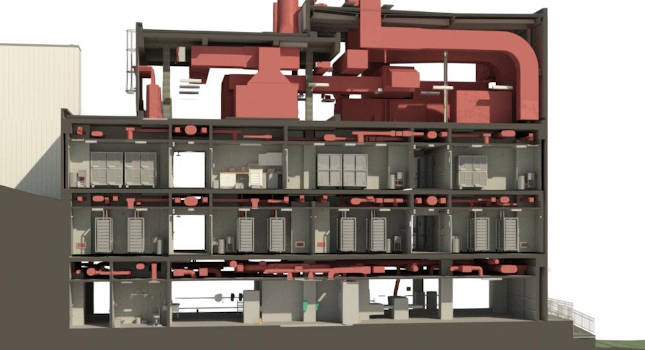In this Q&A with multiple experts, learn how to design HVAC and plumbing systems government, state, municipal, federal, correctional and military buildings

Respondents
- Steve C. Davis, PE, electrical discipline lead, LEO A DALY, Atlanta
- Raymond Krick III, PE, CxA, LEED AP, project manager, RMF Engineering Inc., Baltimore
- Allen Poppe, PE, principal mechanical engineer, Stanley Consultants, Muscatine, Iowa
- Andrew Stanton, PE, mechanical engineer | senior associate, DLR Group, Cleveland.
What unique heating or cooling systems have you specified into such projects?
Andrew Stanton: In an original design for a federal courthouse that had an existing component as well as an addition, there was a stress on using the existing building as much as possible to reduce the cost of new construction. Because of this, the existing mechanical room was to be reused but needed to accommodate cooling and heating for both the existing and new buildings. The heating plant was being upgraded from steam to hot water so there was no issue with space as the high-efficiency condensing boilers took up significantly less room. However, the cooling plant needed to double in size while still being able to fit into the existing space. We specified modular chillers with compressors to provide more cooling capacity in a smaller footprint while also allowing for easier installation in an existing building.
When meeting indoor air quality COVID-19 goals, what types of products or systems are being requested?
Raymond Krick III: When designing for indoor air quality as it relates to COVID-19 many of RMF’s clients have requested enhanced filtration, ultraviolet germicidal irradiation and bipolar ionization. RMF follows ASHRAE guidance and recommend minimum of MERV-13 rated filters and UVGI for their proven effectiveness in the control of the spread of the coronavirus.
Allen Poppe: Improved filtration (MERV 13) is regularly implemented. Dedicated outdoor air systems and humidification are common. Systems have been provided with increased ventilation (dilution). We have fielded questions about other technologies like UV disinfection and ionization.
Andrew Stanton: There are several features being requested to help prevent the spread of COVID. The most basic are providing the capacity to supply more outdoor air into the building and a higher level of filter within the building. After these, the next level is ultraviolet light air purification and bipolar ionization systems that are able to eliminate bacteria and viruses (such as COVID-19) from the airstream. Depending on the application, any number of these measures are being requested.
How have you worked with HVAC system or equipment design to increase a building’s energy efficiency?
Allen Poppe: We consider the local climate when selecting and applying HVAC systems. Maximizing the use of air or water side economizer operation is an example.
Andrew Stanton: Our goal as designers is to specify the most energy efficient mechanical equipment the design can support. We consistently include high-efficiency boilers and chillers, pumps and fans on variable frequency drives, use larger water temperature differentials to reducing pumping power and optimize building capacities by using the latest in load calculation modeling software.
What best practices should be followed to ensure an efficient HVAC system is designed for this kind of project?
Raymond Krick III: Defining the control strategies early on in the design process will help to provide an efficient HVAC system. The key is to identify the controls that are required per energy conservation codes and standards and any additional controls that are to be implemented. Then, systems should be designed around those particular strategies. Too often energy conservation measures in the form of controls are compromised when they are an afterthought in the design process. When something as important as the controls are thrown together late in the design, components and sequences are missed, as are the opportunities for energy savings.
Andrew Stanton: We feel high-efficiency, natural gas, condensing boilers with low returning water temperatures are best practice to include in all designs.
What is the most challenging thing when designing HVAC systems in such buildings?
Andrew Stanton: Providing proper security precautions such as negatively pressurized mail rooms, secure outdoor air intake locations and properly zoned air handling units present the largest challenge in federal courthouse buildings.



